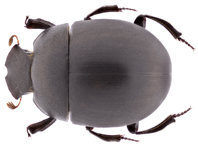Abstract
The demosponge genus Endectyon is characterized by the presence of acanthostyles with recurved or clavulate spines. Two subgenera are recognized, Endectyon and Hemectyon, distinguished mainly by the acanthostyles being located only in the periphery of the axial skeleton in Endectyon, or forming the ectosomal brushes in Hemectyon. Sixteen species are known worldwide, of which only two were reported from the Western Atlantic Ocean. However, the type locality of Endectyon xerampelina is uncertain, and it could be located either in the Western Atlantic or in Australia. In the present study, we describe new records of E. xerampelina from the Brazilian coast and propose that Raspailia (R.) johnhooperi from the Guyana shelf is a junior synonym of E. xerampelina. Our results support the hypothesis that the type locality of E. xerampelina is located somewhere in the Tropical Western Atlantic Ocean and also that the species belongs to the subgenus Endectyon (Endectyon). We amended the diagnosis of the subgenus Endectyon (Endectyon) to account for the variability of acanthostyle shape in E. (E.) xerampelina, assigning greater taxonomic value to the position of the echinating megascleres than to their shape and pattern of spination.
References
Burton, M. (1930) Additions to the Sponge Fauna at Plymouth. Journal of the Marine Biological Association of the United Kingdom, 16 (2) 492–494.
https://doi.org/10.1017/S0025315400072891
Burton, M. (1948) Marine sponges of Congo coast. Institut Royal Colonial Belge Bulletin des Séances, 19 (3), 753–758.
Dendy, A. (1887) The sponge-fauna of Madras. A report on a collection of sponges obtained in the neighbourhood of Madras by Edgar Thurston, Esq. Annals and Magazine of Natural History, Series 5, 20 (117), 153–165.
Dendy, A. (1905) Report on the sponges collected by Professor Herdman, at Ceylon, in 1902. In: Herdman, W.A. (Ed.), Report to the Government of Ceylon on the Pearl Oyster Fisheries of the Gulf of Manaar. 3 (Supplement 18). Royal Society, London, pp. 57–246.
Hajdu, E., Peixinho, S. & Fernandez, J. (2011) Esponjas marinhas da Bahia: Guia de campo e laboratório. Série Livros 45. Museu Nacional, Rio de janeiro, 276 pp.
Hentschel, E. (1912) Kiesel- und Hornschwämme der Aru- und Kei-Inseln. Abhandlungen herausgegeben von der Senckenbergischen naturforschenden Gesellschaft, 34 (3), 293–448.
https://doi.org/10.5962/bhl.title.85325
Hooper, J.N.A. (1991) Revision of the family Raspailiidae (Porifera: Demospongiae), with description of Australian species. Invertebrate Systematics, 5 (6), 1179–1481.
https://doi.org/10.1071/IT9911179
Hooper, J.N.A. (2002) Family Raspailiidae Hentschel, 1923. In: Hooper, J.N.A. & van Soest, R.W.M. (Eds.), Systema Porifera. A Guide to the classification of sponges. Vol. 01. Kluwer Academic/Plenum Publishers, New York, pp. 469–510.
https://doi.org/10.1007/978-1-4615-0747-5_53
Kirkpatrick, R. (1903) Descriptions of South African sponges. Part III. Marine Investigations in South Africa, 2 (14), 233–264.
Lamarck, J.B.P. de M.C. de (1815) (1814) Suite des polypiers empâtés. Mémoires du Muséum d’Histoire naturelle, Paris, 1, 69–80 + 162–168 + 331–340.
Lévi, C. (1953) Sur une nouvelle classification des Démosponges. Compte rendu hebdomadaire des séances de l’Académie des Sciences, Paris, 236 (8), 853–855.
Nardo, G.D. (1833) Auszug aus einem neuen System der Spongiarien, wornach bereits die Aufstellung in der Universitäts-Sammlung zu Padua gemacht ist. Isis, oder Encyclopädische Zeitung Coll. Oken, Jena, pp. 519–523.
Schmidt, O. (1870) Grundzüge einer Spongien-Fauna des atlantischen Gebietes. Wilhelm Engelmann, Leipzig, 88 pp.
Sitjà, C. & Maldonado, M. (2014) New and rare sponges from the deep shelf of the Alboran Island (Alboran Sea, Western Mediterranean). Zootaxa, 3760 (2), 141–179.
https://doi.org/10.11646/zootaxa.3760.2.2
Sollas, W.J. (1885) A classification of the sponges. Annals and Magazine of Natural History, Series 5, 16 (95), 395.
https://doi.org/10.1080/00222938509459901
Spalding, M.D., Fox, H.E., Allen, G.R., Davidson, N., Ferdaña, Z.A., Finlayson, M., Halpern, B.S., Jorge, M.A., Lombana, A., Lourie, S.A., Martin, K.D., McManus, E., Molnar, J., Recchia, C.A. & Robertson, J. (2007) Marine ecoregions of the world: a bioregionalization of coastal and shelf areas. Bioscience, 57, 573–583.
https://doi.org/10.1641/b570707
Thomas, P.A. (1976) Endectyon lamellosa n. sp., (Demospongiae: Poecilosclerida, Raspailidae) from the Indian Seas and a revised key to the Indian species of Endectyon Topsent. Journal of the Marine Biological Association of India, 18 (1), 169–172.
Topsent, E. (1892) Diagnoses d’éponges nouvelles de la Méditerranée et plus particulièrement de Banyuls. Archives de Zoologie expérimentale et générale, 2 Notes et Revue, 10, 17–28.
Topsent, E. (1920) Spongiaires du Musée Zoologique de Strasbourg. Monaxonides. Bulletin de l’Institut océanographique, Monaco, 381, 1–36.
Topsent, E. (1932) Éponges de Lamarck conservées au Muséum de Paris. Deuxieme partie (I). Archives du Museum National d'Histoire Naturelle, Paris, 6 (8), 61–124.
Vacelet, J. (1961) Spongiaires (Démosponges) de la région de Bonifacio (Corse). Recueil des Travaux de la Station marine d’Endoume, 22 (36), 37–39.
Van Soest, R.W.M. (2017) Sponges of the Guyana Shelf. Zootaxa, 4217, 1–225.
https://doi.org/10.11646/zootaxa.4217.1.1
van Soest, R.W.M, Boury-Esnault, N., Hooper, J.N.A., Rützler, K., de Voogd, N.J., Alvarez de Glasby, B., Hajdu, E., Pisera, A.B., Manconi, R., Schoenberg, C., Klautau, M., Picton, B., Kelly, M., Vacelet, J., Dohrmann, M., Díaz, M.-C., Cárdenas, P. & Carballo, J.L. (2019) World Porifera database. Available from: http://www.marinespecies.org/porifera (accessed 25 January 2019)
Wells, H.W., Wells, M.J. & Gray, I.E. (1960) Marine sponges of North Carolina. Journal of the Elisha Mitchell Scientific Society, 76 (2), 200–245.

